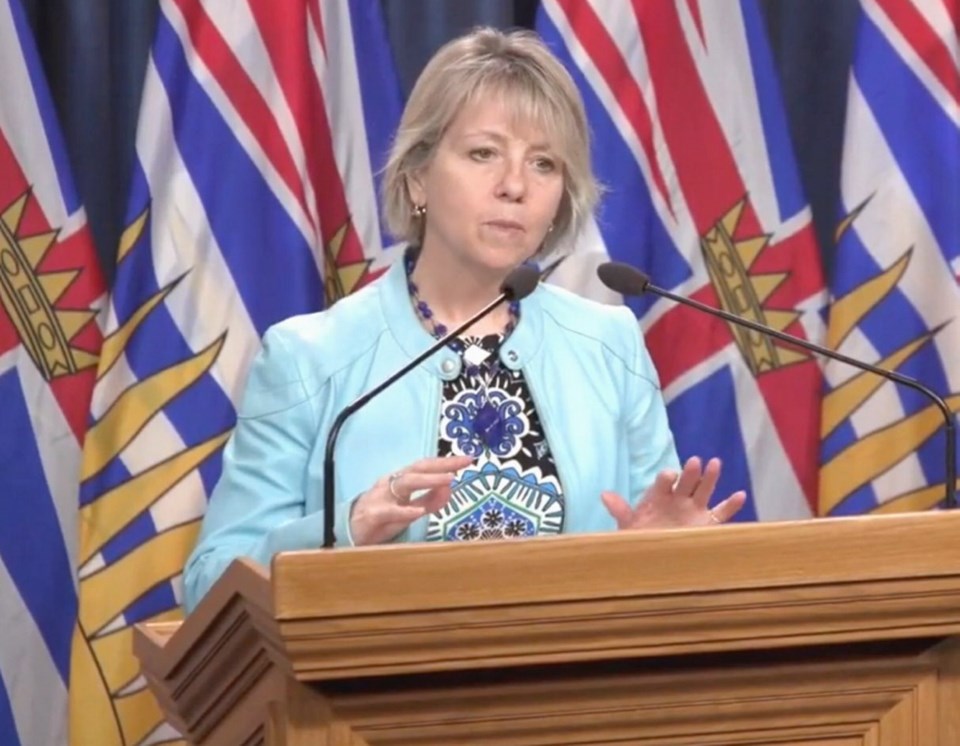Another person has died and there are 92 more confirmed cases of COVID-19 in B.C., the biggest increase in one day yet, health officials said Saturday.
B.C. now has 884 confirmed cases of the novel coronavirus and 17 deaths.
Three new cases were reported in the Island Health region, for a total of 60, and three people are hospitalized in the region, which has about 794,000 people.
“It’s not unexpected given where we are in the outbreak,” said Dr. Bonnie Henry, B.C.’s provincial health officer. Henry noted that while the figure is the highest for one day, the percentage of the increase has not spiked dramatically.
“Everything we do now is really important to prevent transmission,” she said, calling on British Columbians to keep up with physical distancing measures, which officials believe might be “flattening the curve.”
Officials did not release the location of where the death occurred, but said it was in the Vancouver Coastal Health region.
Henry said there are now 12 long-term care facilities where a staff worker has been infected with the virus, up from 11 on Friday. Of those, six are in the Vancouver Coastal Health region, and six are in the Fraser Health region.
She said officials have set up outbreak protocols at the affected care homes.
Eighty-one people are in hospital and, of those, 52 patients are in intensive care.
Henry noted Saturday that the number of patients in ICU has gone up due to early use of ventilators, which she said can speed up recovery.
Henry said 386, or 45 per cent, of patients with the virus have recovered and no longer need to be in isolation.
Of the total cases, 444 are in the Vancouver Coastal Health region, 291 are in Fraser Health, 60 are on Vancouver Island, 77 are in the Interior, and 12 are in the Northern Health region.
Henry said health officials continue to test thousands of people with symptoms but there are no plans to conduct widespread testing of asymptomatic people. There are some exceptions, for example people who have come into contact with infected people at long-term care homes.
They are also testing anti-malarial and antiviral drugs in trials at an undisclosed facility. Henry said health officials will be examining the results to see how effective the treatments are.
B.C. health officials said Friday that physical distancing had started to slow the rate of growth of COVID-19 in the province by as much as half, something Prime Minister Justin Trudeau noted in his daily address Saturday, saying B.C.’s numbers indicated a flattening of the curve.
“We need you to continue to stay home,” Trudeau said.
“We need you to do everything you can to flatten the curve. Obviously there are sacrifices we are all making, but it is beginning to work.”
On Friday, health officials released modelling data for four scenarios based in part on what has happened in other countries, emphasizing that they are preparing for the worst possible scenario, regardless of whether or not it’s the most likely.
“This is modelling so it is not a prediction,” Henry said.
“It’s a set of parameters that allow us to make some rational decisions about planning.”
Based on trends here and elsewhere, B.C. officials have assumed that about 14 per cent of novel coronavirus patients (one in seven) would need to be hospitalized for about 12 days.
A further five per cent (one in 20) would need to spend 10 days in critical care.
Most of the latter group (80 per cent) would require the assistance of a mechanical ventilator to breathe.
B.C. appears positioned tomanage through an outbreak mirroring either the Chinese or Korean scenarios, rather than Italy, which was identified as a worst-case scenario, with the model showing 2,742 hospitalizations.
Based on the current rate of increase, Henry suggested the more plausible peak for B.C. is 2,000 to 3,000 cases.
Asked Saturday when B.C. might see cases peak, the provincial health officer said: “We don’t know the peak until we’re looking back at it.
“We need to continue to monitor and follow everything on a daily basis to see if we are flattening that curve.
“If we start seeing a consistently decreasing number of new cases per day, everything else being equal, that usually tells us.”



